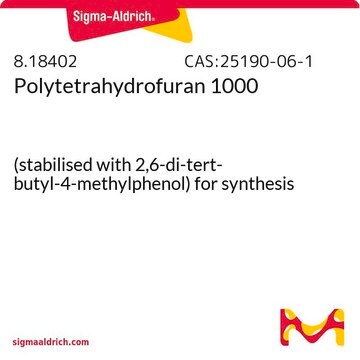345296
Poly(tetrahydrofuran)
average Mn ~1,000
Synonym(s):
α-Hydro-ω-hydroxypoly(oxy-1,4-butanediyl), Poly(1,4-butanediol), polyTHF
About This Item
Recommended Products
vapor pressure
<0.01 mmHg ( 25 °C)
<1 mmHg ( 20 °C)
Quality Level
mol wt
average Mn ~1,000
contains
0.05-0.07% BHT as stabilizer
mp
25-33 °C
density
0.974 g/mL at 25 °C
SMILES string
OCCCCO
InChI
1S/C8H18O2/c1-3-5-6-10-8(4-2)7-9/h8-9H,3-7H2,1-2H3/t8-/m0/s1
InChI key
BJZYYSAMLOBSDY-QMMMGPOBSA-N
Looking for similar products? Visit Product Comparison Guide
Related Categories
Application
- Thermally reversible urethane -epoxy networks.
- Poly(hexamethylene 2,6-naphthalate)-block-poly(tetrahydrofuran) (PHN-b-N-pTHF) copolymers with shape memory effect via melt polycondensation.
- Poly(3,4-ethylenedioxythiophene):poly(tetrahydrofuran) composite for the fabrication of memory organic electrochemical transistors.
Features and Benefits
- High flexibility
- Hydrolytic stability
- Excellent abrasion resistance
Storage Class
11 - Combustible Solids
wgk_germany
WGK 3
flash_point_f
>325.4 °F - Tag open cup
flash_point_c
> 163 °C - Tag open cup
ppe
dust mask type N95 (US), Eyeshields, Gloves
Choose from one of the most recent versions:
Already Own This Product?
Find documentation for the products that you have recently purchased in the Document Library.
Our team of scientists has experience in all areas of research including Life Science, Material Science, Chemical Synthesis, Chromatography, Analytical and many others.
Contact Technical Service







